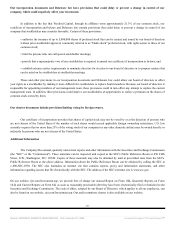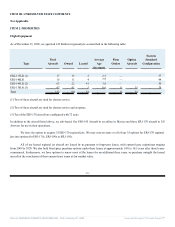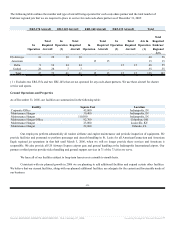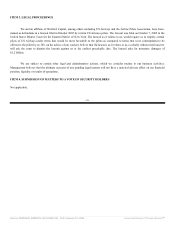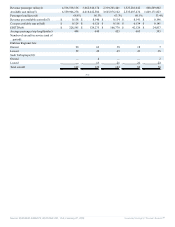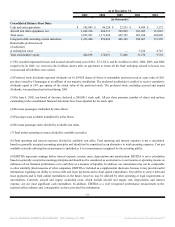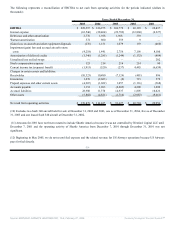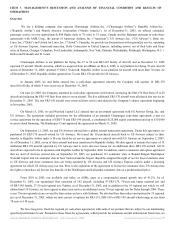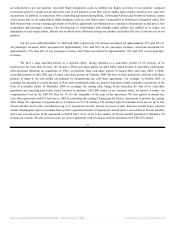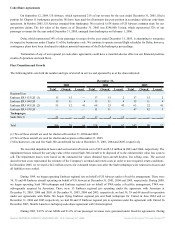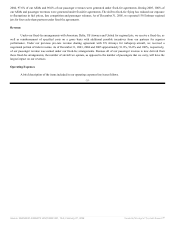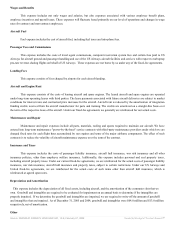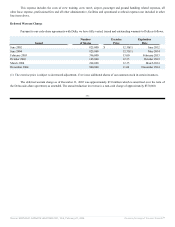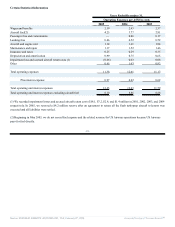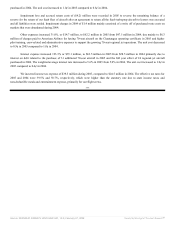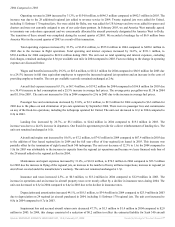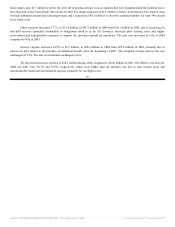Frontier Airlines 2005 Annual Report Download - page 56
Download and view the complete annual report
Please find page 56 of the 2005 Frontier Airlines annual report below. You can navigate through the pages in the report by either clicking on the pages listed below, or by using the keyword search tool below to find specific information within the annual report.
are authorized to use our partners' two-letter flight designation codes to identify our flights and fares in our partners' computer
reservation systems, to paint our aircraft in the style of our partners, to use their service marks and to market ourselves as a carrier for
our partners. In addition, in connection with a marketing agreement among Delta, Continental Airlines and Northwest Airlines, certain
of the routes that we fly using Delta's flight designator code are also flown under Continental's or Northwest's designator codes. Our
shift from pro-rate revenue sharing agreements to fixed-fee agreements has eliminated our exposure to fluctuations in fuel prices, fare
competition and passenger volumes. Our development of relationships with multiple major airlines has enabled us to reduce our
dependence on any single airline, allocate our overhead more efficiently among our partners and reduce the cost of our services to our
partners.
For the years ended December 31, 2005 and 2004, respectively, US Airways accounted for approximately 21% and 38% of
our passenger revenues, Delta accounted for approximately 34% and 36% of our passenger revenues, American accounted for
approximately 13% and 16% of our passenger revenues and United accounted for approximately 32% and 10% of our passenger
revenues.
We have a long operating history as a regional airline, having operated as a code-share partner of US Airways or its
predecessors for more than 30 years. We became a TWA code-share partner in April 2000, which became a code-share relationship
with American following its acquisition of TWA, an America West code-share partner in August 2001 until June 2003, a Delta
code-share partner in June 2002 and a United code-share partner in February 2004. We have worked proactively with our code-share
partners to adapt to the new airline environment by renegotiating our code-share agreements. For example, in October 2003, in
exchange for agreeing to extend the date of their early termination right, we granted American certain economic concessions in the
form of a monthly rebate. In December 2004, in exchange for, among other things, Delta extending the term of its code-share
agreement and canceling previously issued warrants to purchase 2,025,000 shares of our common stock, we agreed to reduce our
compensation level on the ERJ-145 fleet by 3% for the remainder of the term of the agreement. We also agreed to amend our
code-share agreement with US Airways in 2005 by amending the existing Chautauqua Jet Service Agreement to provide for, among
other things, the operation of regional jets at a reduced cost to US Airways, US Airways' right to terminate from service up to five
50-seat aircraft, and in other circumstances up to 15 regional jet aircraft, but not in excess of more than two aircraft in any calendar
month; Chautauqua's right to terminate from service a specified number of regional jet aircraft (not to exceed fifteen 50-seat aircraft);
and a one-year extension of the agreement to March 2013. In no event is the number of 50-seat aircraft permitted to fall below 20
without our consent. We also received a new jet service agreement with US Airways for the operation of 28 ERJ-170 aircraft.
-34-
Source: REPUBLIC AIRWAYS HOLDINGS INC, 10-K, February 27, 2006 Powered by Morningstar® Document Research℠


